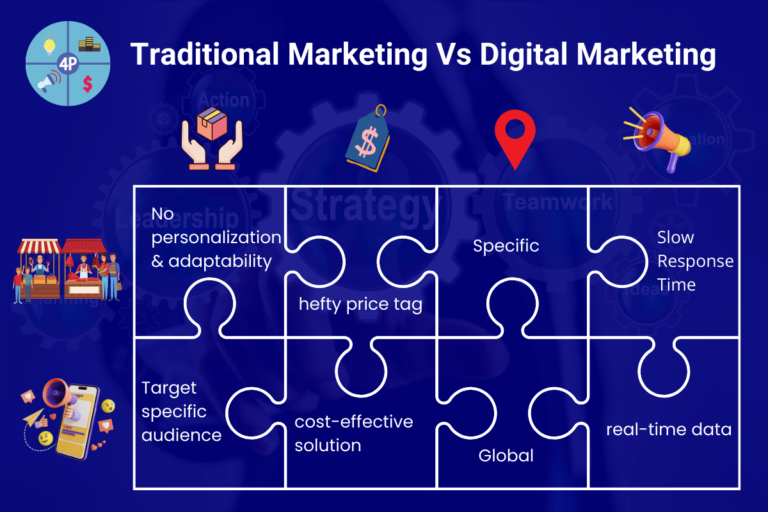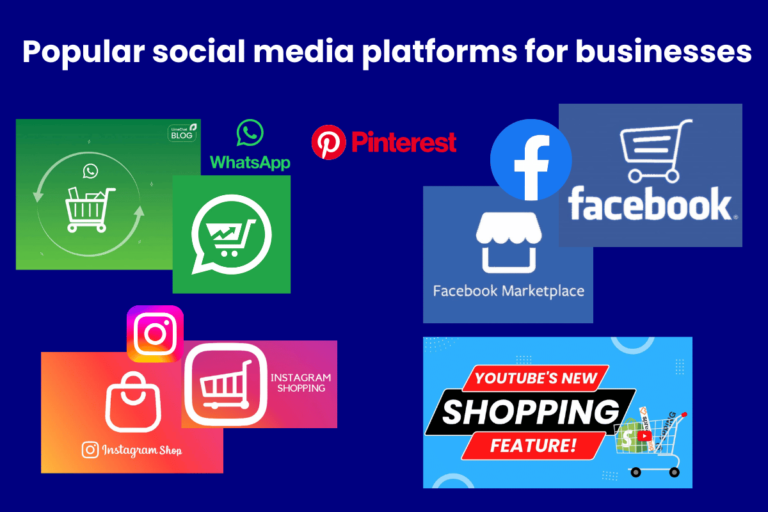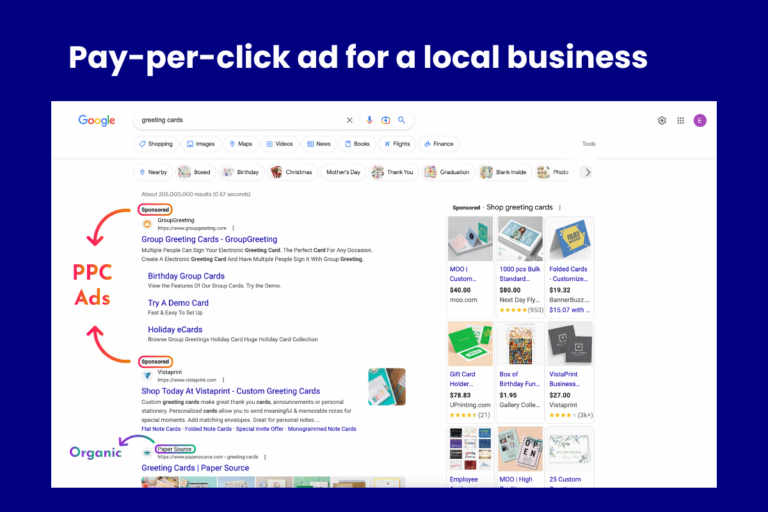Table of Contents
ToggleIntroduction: The Digital Edge for Local Businesses

Don’t Get Left Behind: The Importance of Online Presence for Local Businesses
Imagine this: You’re looking for a nearby coffee shop, a trusted electrician, or the best place to buy organic produce. What’s the first thing you do? You pull out your phone and Google it. But what happens if a business doesn’t show up in that search? It might as well not exist. This is the reality for many local businesses that don’t have a strong online presence.
Local businesses, whether family-run stores, small service providers, or neighbourhood shops, are the backbone of our communities. They provide essential services, offer personalized customer experiences, and contribute to the local economy.
However, in today’s fast-evolving market, local businesses face numerous challenges. Fierce competition from larger chains, changing consumer preferences, and economic uncertainties can make it difficult for them to thrive.
One of the biggest obstacles is the shift in consumer behaviour. With more people shopping and searching online, the traditional foot traffic that once sustained local businesses is no longer enough. Without an online presence, businesses risk being overlooked, regardless of how good their services are.
This blog aims to highlight why it’s no longer just an option, but a necessity, for local businesses to have a strong digital presence. From improving visibility to connecting with the right audience, embracing digital marketing is the key to staying relevant and competitive in today’s digital age.
Understanding Local Businesses
SWOT Analysis of Local Businesses

Local businesses hold a special place in their communities. They offer personalized experiences and play a key role in supporting the local economy.
However, like any other business, they face their own set of strengths, weaknesses, opportunities, and threats.
Here’s a look at the SWOT analysis for local businesses
Strengths
One of the greatest strengths of local businesses is their personalized service. Unlike large corporations, local businesses can build personal relationships with their customers, providing unique, tailored experiences that keep people coming back
They are also often closely involved in the community, which fosters loyalty among local residents. This community connection allows local businesses to be more flexible and adaptable to the specific needs of their customer base.
Weaknesses
On the flip side, local businesses frequently face challenges such as limited resources. With smaller budgets, they may struggle to invest in modern technology or comprehensive marketing strategies.
Many local businesses also lack in-house marketing expertise, making it difficult to compete with larger competitors that have access to sophisticated advertising platforms.
Additionally, staffing limitations and logistical challenges can impact the efficiency and scale of their operations.
Opportunities
Despite these challenges, local businesses have several growth opportunities. The rise of e-commerce and digital marketing opens up new avenues for local businesses to expand their reach.
By embracing social media and SEO, they can tap into a larger audience that goes beyond their immediate locality.
Moreover, offering online services or delivery options can help attract tech-savvy customers and increase convenience for existing ones.
Participating in local events and fostering online community engagement can further strengthen their presence and brand loyalty.
Threats
However, local businesses face external threats that could hamper their success.
An economic downturn can lead to reduced spending, while increased competition from big-box retailers and e-commerce giants can make it difficult for local businesses to survive.
Changing consumer preferences—where people prioritize convenience and price over local loyalty—also pose a significant threat.
Additionally, the regulatory environment can sometimes be burdensome for smaller enterprises, creating additional operational challenges.
Limitations of Traditional Marketing
Traditional marketing methods, such as print ads, billboards, and newspaper inserts, have long been the go-to strategies for local businesses. However, these methods come with significant limitations, making it difficult for small and local businesses to stay competitive in today’s digital world.
Limited Reach
Traditional marketing has a restricted geographic reach, typically confined to local audiences or specific regions. For instance, a newspaper ad might only be seen by those who subscribe, while a billboard captures the attention of passersby in a limited area. This narrow scope makes it challenging for businesses to reach broader, more diverse audiences.
Higher Costs
The cost of traditional marketing can be prohibitive for small businesses. Print ads, TV spots, and billboards often require large upfront investments. Once the campaign is deployed, there is no flexibility for real-time adjustments.
In contrast, digital marketing allows for smaller budgets and more scalable options.
Lack of Precision
Traditional marketing lacks the precision targeting that digital marketing offers. It cannot segment audiences by demographics, interests, or behaviours. A one-size-fits-all message may not resonate with the entire audience, leading to wasted resources and lower engagement.
Slow Response Time
Traditional methods like direct mail or print ads take time to produce, distribute, and assess. There is no way to gauge instant feedback or make changes on the fly. This slow response time can cause businesses to miss out on timely opportunities or market shifts.
Difficulty in measuring ROI
One of the biggest drawbacks of traditional marketing is the difficulty in measuring its return on investment (ROI). It’s nearly impossible to track how many people saw a billboard or how effective a print ad was in driving sales. Without clear metrics, businesses struggle to assess the success of their marketing efforts.
When comparing traditional marketing to digital marketing, the latter stands out for its effectiveness and efficiency. Digital marketing offers targeted reach, lower costs, real-time feedback, and clear measurability. While traditional marketing still has its place in some cases, local businesses should embrace digital strategies to thrive in today’s competitive environment.
The Power of Digital Marketing for Local Businesses

Why Digital Marketing is Essential for Local Businesses
In today’s digital world, a strong online presence isn’t just optional for local businesses—it’s a must. Digital marketing lets local businesses reach way more people than ever before. With tools like local SEO, social media, and online ads, you can target exactly who you want.
One big advantage is increased visibility. People searching for what you offer can easily find you online. Plus, platforms like Google My Business let you chat with customers directly, building better relationships.
Digital marketing also boosts sales. Targeted ads, emails, and retargeting can bring in new customers and keep old ones coming back. And with consistent online activity, your brand becomes more well-known, attracting loyal customers.
By using digital marketing, local businesses can thrive, take advantage of new opportunities, and succeed in the long run.
Key Digital Marketing Strategies for Local Businesses
To succeed in today’s competitive environment, local businesses need to adopt a robust digital marketing strategy. Below are some of the key digital marketing strategies that can help local businesses grow, attract new customers, and maintain relationships with existing ones.
SEO is crucial for local businesses to improve their visibility on search engines like Google. When potential customers search for products or services, a strong SEO strategy ensures that your business appears at the top of search results.
On-Page SEO: This involves optimizing the content on your website, including using relevant keywords, meta descriptions, title tags, and proper formatting. Ensure that your site’s content is easy to read and includes keywords that reflect the search queries of your target audience.
Off-Page SEO: This focuses on actions outside your website, like building backlinks from authoritative websites and increasing your online presence through guest blogging or media mentions.
Local Business Listings: For local businesses, optimizing your Google My Business (GMB) listing is critical. Make sure your GMB profile is complete with up-to-date information, customer reviews, and photos. This will help you rank better in local searches and appear on Google Maps.
Tips for Local SEO: Claim your GMB listing, keep your business information consistent across online directories, and encourage satisfied customers to leave reviews.
Content Marketing
High-quality content helps local businesses engage with their audience, build trust, and establish themselves as experts in their field. Content marketing can take the form of blog posts, videos, infographics, and more.
Creating Resonant Content: Understand the needs and pain points of your target audience. Your content should provide value, answer their questions, or solve their problems. For instance, if you’re an agri-input trader, you could write blog posts on sustainable farming practices or tips for maximizing crop yield.
Promoting Content: Once your content is created, promote it on social media platforms, through email marketing, and on your website. The goal is to ensure that your target audience sees your content and interacts with it. Content marketing, when done correctly, also helps improve your SEO ranking.
Tips for Promoting Content: Use a mix of blog posts, video content, and social media posts to engage different segments of your audience. Create a content calendar to consistently share valuable information
Social Media Marketing
Social media platforms offer local businesses a way to connect directly with their community. Social media allows businesses to showcase their products, offer promotions, and communicate with customers in real-time.

Popular Platforms: For local businesses, platforms like Facebook, Instagram, and WhatsApp are particularly effective. Facebook allows businesses to create detailed business profiles, run targeted ads, and engage in community groups. Instagram is perfect for visually showcasing your products or services, while WhatsApp can be used for direct communication with customers.
Engaging Content: Post regularly with a mix of content types, such as photos, videos, and polls. Share stories of your business, promote your products, or even post user-generated content to build stronger relationships with your audience.
Tips for Social Media Content: Use hashtags that are relevant to your community, host giveaways or contests, and post testimonials or customer reviews to build trust.
Local SEO
Local SEO is a specialized form of search engine optimization that focuses on helping local businesses rank higher in local search results. Local SEO helps businesses appear in searches made by customers nearby who are looking for products or services in their area.

Website Optimization: Make sure your website is optimized for local search by including location-specific keywords, such as “best bakery in Mumbai” or “plumber near me.”
Google My Business Optimization: Claim your Google My Business listing and optimize it with accurate business information, operating hours, and customer reviews. Add relevant photos and ensure that your business categories are correct.
Tips for Local SEO: Focus on getting good reviews and keep your NAP (Name, Address, Phone number) consistent across all online platforms.
PPC advertising allows businesses to bid on keywords and appear at the top of search results or on social media platforms. Local businesses can use PPC ads to reach specific target audiences and drive immediate traffic to their website.

Popular PPC Platforms: Google Ads and Facebook Ads are two of the most effective platforms for PPC advertising. Google Ads allows you to bid on local keywords, while Facebook Ads enables you to target users based on location, demographics, and interests.
Effective PPC Campaigns: The key to a successful PPC campaign is selecting the right keywords, setting a clear budget, and crafting compelling ad copy that encourages users to click through. PPC offers flexibility, allowing you to adjust your ads in real-time based on performance.
Tips for PPC: Set a clear goal (e.g., increase website traffic, boost sales), and use A/B testing to identify the most effective ad copy and targeting.
Email Marketing
Email marketing is one of the most cost-effective ways for local businesses to stay in touch with customers, announce new products or services, and send special offers or discounts.
Building Relationships: Use email marketing to provide value to your customers, such as by sending newsletters, updates on promotions, or useful tips. This can help foster long-term relationships and keep your business top of mind.
Best Practices for Emails: Segment your email list so that you can send more personalized messages to different groups of customers. Ensure your emails are mobile-friendly and include a clear call-to-action (CTA) that encourages engagement.
Tips for Email Campaigns: Send personalized emails, offer exclusive discounts, and include a clear call-to-action to drive engagement.
By incorporating these digital marketing strategies, local businesses can significantly enhance their visibility, attract new customers, and build long-term relationships, all of which are essential for sustained growth.
Traditional Marketing Vs. Digital Marketing

When evaluating traditional marketing methods like print ads, billboards, and flyers against digital marketing strategies like SEO and social media, it’s essential to look at the comparison through the lens of the 4 Ps of marketing—Product, Price, Place, and Promotion.
Product
Traditional marketing typically showcases the product through static media such as print advertisements or billboards. This approach often needs more personalization and adaptability. Once a message is out, changes are hard to make, making it less flexible for different audiences.
With digital marketing, however, businesses can adapt their product messaging to specific audiences instantly. For example, social media platforms allow for direct interaction with potential customers, where businesses can quickly alter product descriptions, create dynamic content, and respond to customer feedback in real-time. This helps local businesses tailor their offerings according to the market’s needs.
Price
Traditional marketing methods often come with a hefty price tag, especially for small businesses. Print ads, billboards, and TV commercials can require a significant upfront investment, which can be hard to justify, particularly for local businesses with limited budgets.
Digital marketing, by contrast, offers a much more cost-effective solution. Strategies like SEO, email marketing, and social media are relatively affordable and allow for better budget control. For instance, businesses can start a pay-per-click (PPC) campaign with as little as a few dollars and scale it as needed, ensuring they get the most return for their investment.
Place
Traditional marketing typically targets a broad audience in a specific geographic location—such as people driving past a billboard or receiving a flyer in the mail. However, these methods have limited reach and can only capture a fraction of the target market.
In digital marketing, place is no longer confined to physical locations. The internet allows businesses to reach a global audience or hyper-targeted local customers based on their preferences, behaviours, and demographics. This allows local businesses to attract a far wider and more engaged audience than traditional methods ever could.
Promotion
Traditional promotional methods are harder to track and measure. For example, it’s difficult to determine the effectiveness of a newspaper ad in driving sales or engaging potential customers. Moreover, these methods usually don’t offer instant feedback, making it hard to assess campaign performance.
Digital marketing provides accurate, real-time data on campaign performance. Local businesses can track every click, impression, and conversion through tools like Google Analytics or social media insights. This means business owners can make data-driven decisions, adjust strategies quickly, and get a clear understanding of their marketing ROI.
When comparing the two, digital marketing stands out for its reach, precision targeting, and measurability. It provides local businesses with the ability to engage with the right customers at the right time and place, all while offering flexibility and a better return on investment. Whether it’s SEO for improving visibility, or social media for engaging customers, digital marketing is a clear winner in today’s competitive market.
Conclusion: The Future of Local Businesses Lies in a Strong Online Presence
In today’s digital age, local businesses face a rapidly changing landscape, where traditional marketing methods fall short of meeting modern demands. Through this blog, we’ve explored the unique strengths and challenges of local businesses, the limitations of traditional marketing, and the undeniable power of digital marketing to propel small businesses forward.
The ability to reach a broader audience, engage customers more effectively, and measure success with precision are just a few reasons why digital marketing is essential for local businesses. Strategies such as SEO, content marketing, social media, and email marketing can help local businesses increase visibility, enhance customer relationships, and boost sales, all while being cost-effective and highly targeted.
Now more than ever, local businesses must embrace digital transformation to stay competitive and grow. Whether you’re a small business owner, rural entrepreneur, or MSME, it’s time to start building your online presence. Implementing digital marketing strategies will not only future-proof your business but also open doors to new growth opportunities. Take the first step today toward a more successful, digitally-driven future for your local business.
